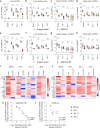Resilience of S309 and AZD7442 monoclonal antibody treatments against infection by SARS-CoV-2 Omicron lineage strains
- PMID: 35780162
- PMCID: PMC9250508
- DOI: 10.1038/s41467-022-31615-7
Resilience of S309 and AZD7442 monoclonal antibody treatments against infection by SARS-CoV-2 Omicron lineage strains
Abstract
Omicron variant strains encode large numbers of changes in the spike protein compared to historical SARS-CoV-2 isolates. Although in vitro studies have suggested that several monoclonal antibody therapies lose neutralizing activity against Omicron variants, the effects in vivo remain largely unknown. Here, we report on the protective efficacy against three SARS-CoV-2 Omicron lineage strains (BA.1, BA.1.1, and BA.2) of two monoclonal antibody therapeutics (S309 [Vir Biotechnology] monotherapy and AZD7442 [AstraZeneca] combination), which correspond to ones used to treat or prevent SARS-CoV-2 infections in humans. Despite losses in neutralization potency in cell culture, S309 or AZD7442 treatments reduced BA.1, BA.1.1, and BA.2 lung infection in susceptible mice that express human ACE2 (K18-hACE2) in prophylactic and therapeutic settings. Correlation analyses between in vitro neutralizing activity and reductions in viral burden in K18-hACE2 or human FcγR transgenic mice suggest that S309 and AZD7442 have different mechanisms of protection against Omicron variants, with S309 utilizing Fc effector function interactions and AZD7442 acting principally by direct neutralization. Our data in mice demonstrate the resilience of S309 and AZD7442 mAbs against emerging SARS-CoV-2 variant strains and provide insight into the relationship between loss of antibody neutralization potency and retained protection in vivo.
© 2022. The Author(s).
Conflict of interest statement
M.S.D. is a consultant for Inbios, Vir Biotechnology, Senda Biosciences, and Carnival Corporation, and on the Scientific Advisory Boards of Moderna and Immunome. The Diamond laboratory has received funding support in sponsored research agreements from Moderna, Vir Biotechnology, and Emergent BioSolutions. J.E.C. has served as a consultant for Luna Innovations, Merck, and GlaxoSmithKline, is a member of the Scientific Advisory Board of Meissa Vaccines and is founder of IDBiologics. The Crowe laboratory has received sponsored research agreements from AstraZeneca, Takeda, and IDBiologics during the conduct of the study. Vanderbilt University has applied for patents for some of the antibodies in this paper, for which J.E.C. is an inventor. B.G., M.A.S, G.S., H.V.D., H.W.V., D.C., and L.A.P. are employees of Vir Biotechnology and may hold equity in Vir Biotechnology. L.A.P. is a former employee and may hold equity in Regeneron Pharmaceuticals. H.W.V. is a founder and holds shares in PierianDx and Casma Therapeutics. Neither company provided resources to this study. Y.K. has received unrelated funding support from Daiichi Sankyo Pharmaceutical, Toyama Chemical, Tauns Laboratories, Inc., Shionogi & Co. LTD, Otsuka Pharmaceutical, KM Biologics, Kyoritsu Seiyaku, Shinya Corporation, and Fuji Rebio. K. Rosenthal, K. Ren, Y-M.L. and M.T.E. are employees of AstraZeneca and may hold stock in AstraZeneca. All other authors declare no competing interests.
Figures




References
-
- Liu, L. et al. Striking Antibody Evasion Manifested by the Omicron Variant of SARS-CoV-2. Nature, 10.1038/s41586-021-04388-0 (2021). - PubMed
Publication types
MeSH terms
Substances
Supplementary concepts
Grants and funding
LinkOut - more resources
Full Text Sources
Other Literature Sources
Medical
Molecular Biology Databases
Miscellaneous

